|
Mountain Trek / Dolpo Region / Nepal Shey Phoksundo Lake TrekNext tentative Date: Available as a Private Trek on a date of your preference.
Traverse through stunning green forests and along a gushing river to Dolpo's Shey Phoksundo Lake on an adventure of a lifetime! |
Overview
Highlights
| Lovely flight from Nepalgunj to Juphal, watching the landscape beneath change drastically from flats to rolling hills to mountainous. | |
| Walking around Shey Phoksundo Lake surrounded by towering rocky and snowcapped mountains. | |
| Birds eye view of the lake and Ringmo village seen from a vantage point two hours away from Ringmo. | |
| Rustic lifestyle of people in some of the most secluded regions of the Himalayas | |
| Trekking through the narrow valley up from Suligad along the gushing blue Phoksundo River, run-off of Shey Phoksundo Lake. | |
| Giant waterfall fed by the lake, seen from the viewpoint before reaching Ringmo |
The Shey Phoksundo Lake Trek is a moderate trek that is suitable for trekkers with a reasonable level of physical fitness. The trek involves walking for about 4 to 6 hours each day on mostly rocky and rugged trails. The terrain is generally not too steep, but there are some gradual ascents and descents as you walk through the beautiful landscapes. The risk of altitude sickness is very low as you will not reach a significant elevation.
Dolpo region is very remote and a big part of the trip is just getting to the trailhead, and back. The teahouse accommodations along the route are much more basic compared to more popular trekking areas but you will be provided with basic food and lodging. Our experienced and well equipped team of guide and porters will help you navigate the trails easily and connect to this culturally rich land and its people.
Best time to go
JanFebMarAprMayJunJulAugSepOctNovDec
JanFebMarAprMayJun
JulAugSepOctNovDec
| Group Sizepax | Fixed Departureprices per person | Regularprices per person |
| 4 - 7 | USD 1640 | |
| 8 & up | USD 1540 |
|
|
|
|
|
Prices valid until Dec 31st, 2026
Prices for expats is less by USD 100

Shey Phoksundo Lake

A Gurung woman with her child
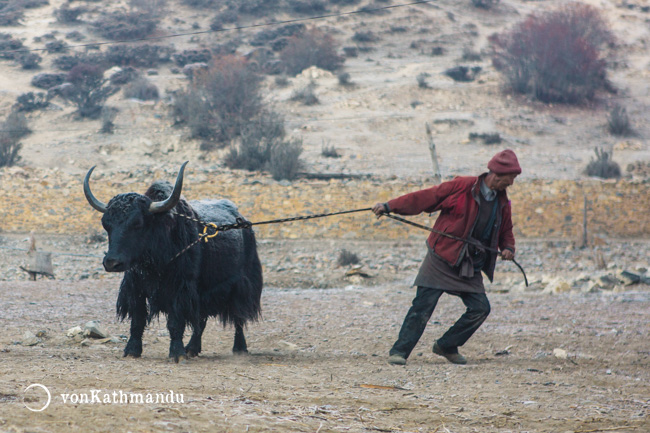
A yak in a frosty winter morning

Ringmo village by the shores of Shey Phoksundo Lake

A porter crossing over a small pass to Forest Camp from Ringmo

Yaks navigate on trails along Shey Phoksundo Lake

Cattle in Ringmo

A tiny Dolpo kid is as big as a doko, traditional bamboo basket

A local lady in Ringmo village

Children herding yaks

Dusk in Dolpo

Situated well below the treeline, Ringmo village and Shey Phoksundo Lake host a wide variety of flora and fauna

A woman gathers twigs and branches in Chharkabhot

Yaks crossing Phoksundo River, run off from the lake

Gurung woman in Kagni

A herd of yaks by Shey Phoksundo Lake

Rolling hills seen on flight to Dolpo

The narrow valley in Dolpo seen trekking down from Shey Phoksundo Lake

Kantega mountain

Shey Phoksundo lake lies at 3,600m above sea level. Its color changes with season, as it accumulates different minerals from glaciers

A monstery in Dolpo, by Shey Phoksundo Lake

Kantega mountain and a Buddhist monument

Alpine trees high above Dunai

A local in Juphal, on the way to Dunai, capital of Dolpo district

Kantega mountain in evening

Phoksundo River a run off from Phoksundo Lake

Shey Phoksundo Lake seen from a vantage point

An airplane approaches Juphal Airport in Dolpo
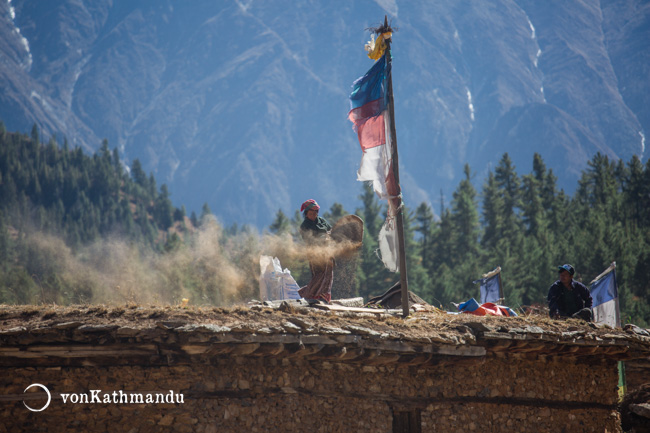
Woman winnows seeds in Ringmo
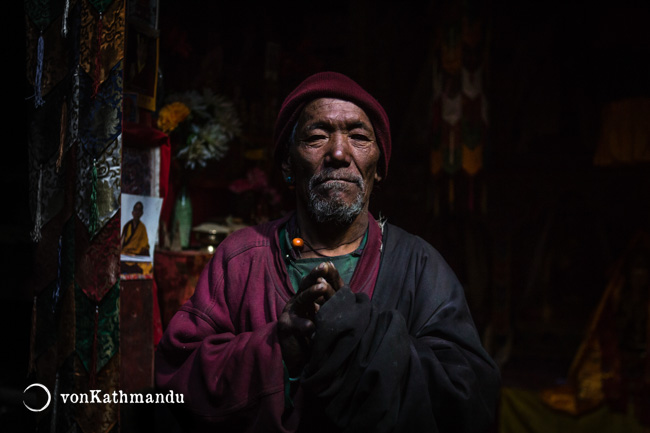
Head monk of a monastery

Gurung child greets namaste

Women in Kagni, on the way to Shey Phoksundo Lake

Kantega mountain
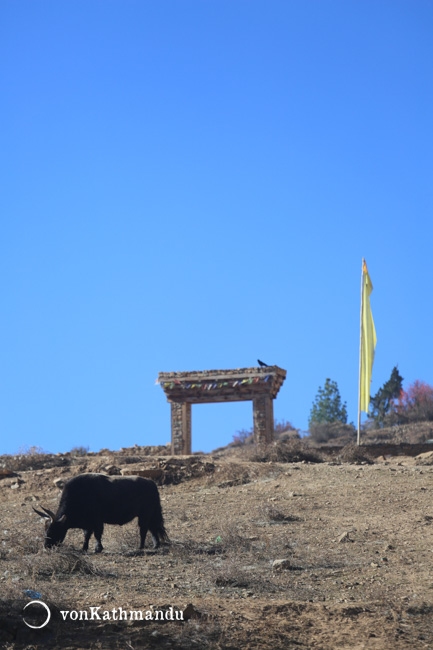
A yak grazes by Shey Phoksundo
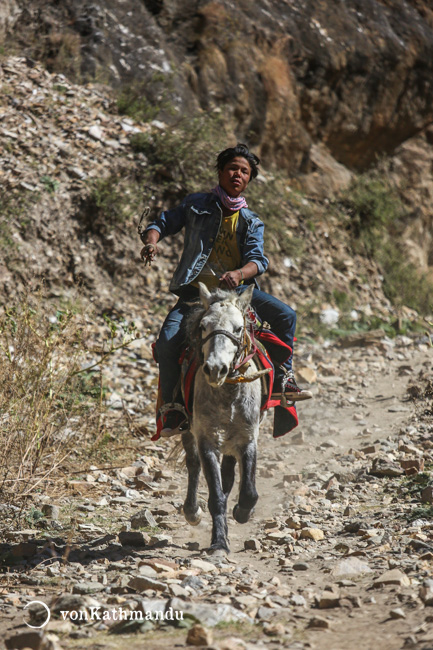
Horses are widely used for commute, through rocky terrains of Dolpo

Buddhist monk spinning a mane, a mini prayer wheel
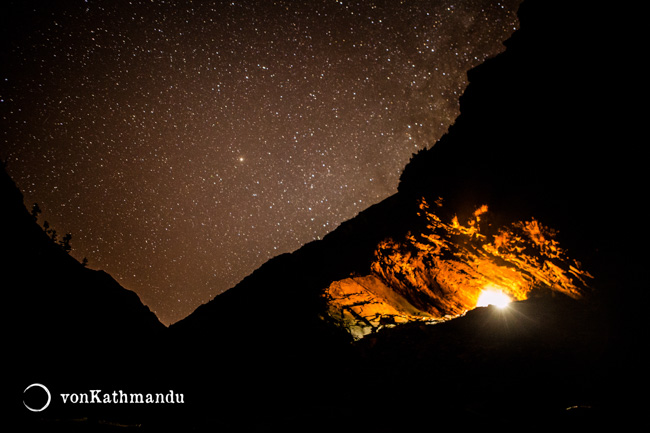
Campfire in a den on a starry night

A porter carries goods to the tiny hamlet of Shey Gompa
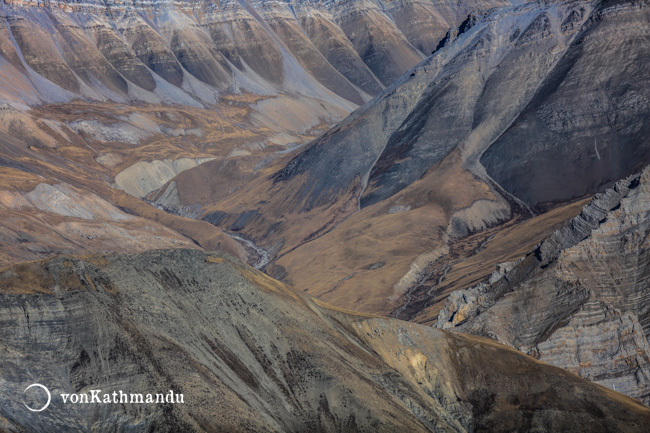
Rugged landscape of Dolpo
Itinerary
|
Day 1 |
Kathmandu - Nepalgunj |
|
|
Day 2 |
Nepalgunj - Juphal - Dunai |
|
|
Day 3 |
Dunai - Chhepka |
|
|
Day 4 |
Chhepka - Jharana |
|
|
Day 5 |
Jharana - Ringmo (Shey Phoksundo Lake) |
|
|
Day 6 |
Ringmo |
|
|
Day 7 |
Ringmo - Chhepka |
|
|
Day 8 |
Chhepka - Juphal |
|
|
Day 9 |
Juhpal - Nepalgunj - Kathmandu |
|
|
Day 1 |
Kathmandu - Nepalgunj |
|
|
Fly from Kathmandu to Nepalgunj 55 mins |
Meals Included: Breakfast
Accommodation: Hotel
|
Day 2 |
Nepalgunj - Juphal - Dunai |
|
|
Fly from Nepalgunj to Juphal 20 mins |
|
|
Trek from Juphal to Dunai 3 hrs |
Meals Included: Breakfast
Accommodation: Mountain Lodge
|
Day 3 |
Dunai - Chhepka |
|
|
Trek from Dunai to Chhepka 6 to 7 hrs |
Meals Included: Breakfast
Accommodation: Mountain Lodge
|
Day 4 |
Chhepka - Jharana |
|
|
Trek from Chhekpa to Jharana 5 to 6 hrs |
Meals Included: Breakfast
Accommodation: Mountain Lodge
|
Day 5 |
Jharana - Ringmo (Shey Phoksundo Lake) |
|
|
Trek from Jharana to Ringmo (Shey Phoksundo Lake) 4 to 4.5 |
Meals Included: Breakfast
Accommodation: Mountain Lodge
|
Day 6 |
Ringmo |
|
|
Explore Ringmo and Shey Phoksundo Lake |
Meals Included: Breakfast
Accommodation: Mountain Lodge
|
Day 7 |
Ringmo - Chhepka |
|
|
Trek from Ringmo to Chhepka 6 to 7 hrs |
Meals Included: Breakfast
Accommodation: Mountain Lodge
|
Day 8 |
Chhepka - Juphal |
|
|
Trek from Chhepka to Juphal 6 to 7 hrs |
Meals Included: Breakfast
Accommodation: Mountain Lodge
|
Day 9 |
Juhpal - Nepalgunj - Kathmandu |
|
|
Fly from Juphal to Nepalgunj 20 mins |
|
|
Fly from Nepalgunj to Kathmandu 55 mins |
Meals Included: Breakfast
Hotel |
X Close Accommodation Popup
X Close Popup
Room Amenities
| • | Free Wi-Fi | • | Room Service | • | Balcony | • | Private Bathroom | • | Hot Shower | • | Free Toiletries | • | Towels | • | Slippers | • | Power Socket | • | Daily Housekeeping |
Property Amenities
| • | Restaurant and Bar | • | Garden | • | Laundry | • | Outdoor Seating | • | Lake Views |
Mountain Lodge |
X Close Accommodation Popup
X Close Popup
Nepal
Mountain lodges are the basic accommodation set up by locals to cater to trekkers in the trails. The common features across all lodges are standard rooms, a spacious and heated dining hall, and a restaurant with a menu. The rooms in mountain lodges generally have two or three twin beds with a mattress and blanket. If you are used to sleeping warm, we highly recommend bringing your own sleeping bag and liner. Other amenities could be a table, hanger, and dustbin but do not expect to have charging ports and attached toilets in the rooms. Moreover, it is mandatory to have meals in the facility you’re staying at.
Room Amenities
| • | Shared Toilet |
Property Amenities
| • | Restaurant and Bar | • | Outdoor Seating | • | Mountain Views |
Mountain Lodge |
X Close Accommodation Popup
X Close Popup
Nepal
Mountain lodges are the basic accommodation set up by locals to cater to trekkers in the trails. The common features across all lodges are standard rooms, a spacious and heated dining hall, and a restaurant with a menu. The rooms in mountain lodges generally have two or three twin beds with a mattress and blanket. If you are used to sleeping warm, we highly recommend bringing your own sleeping bag and liner. Other amenities could be a table, hanger, and dustbin but do not expect to have charging ports and attached toilets in the rooms. Moreover, it is mandatory to have meals in the facility you’re staying at.
Room Amenities
| • | Shared Toilet |
Property Amenities
| • | Restaurant and Bar | • | Outdoor Seating | • | Mountain Views |
Mountain Lodge |
X Close Accommodation Popup
X Close Popup
Nepal
Mountain lodges are the basic accommodation set up by locals to cater to trekkers in the trails. The common features across all lodges are standard rooms, a spacious and heated dining hall, and a restaurant with a menu. The rooms in mountain lodges generally have two or three twin beds with a mattress and blanket. If you are used to sleeping warm, we highly recommend bringing your own sleeping bag and liner. Other amenities could be a table, hanger, and dustbin but do not expect to have charging ports and attached toilets in the rooms. Moreover, it is mandatory to have meals in the facility you’re staying at.
Room Amenities
| • | Shared Toilet |
Property Amenities
| • | Restaurant and Bar | • | Outdoor Seating | • | Mountain Views |
Mountain Lodge |
X Close Accommodation Popup
X Close Popup
Nepal
Mountain lodges are the basic accommodation set up by locals to cater to trekkers in the trails. The common features across all lodges are standard rooms, a spacious and heated dining hall, and a restaurant with a menu. The rooms in mountain lodges generally have two or three twin beds with a mattress and blanket. If you are used to sleeping warm, we highly recommend bringing your own sleeping bag and liner. Other amenities could be a table, hanger, and dustbin but do not expect to have charging ports and attached toilets in the rooms. Moreover, it is mandatory to have meals in the facility you’re staying at.
Room Amenities
| • | Shared Toilet |
Property Amenities
| • | Restaurant and Bar | • | Outdoor Seating | • | Mountain Views |
Mountain Lodge |
X Close Accommodation Popup
X Close Popup
Nepal
Mountain lodges are the basic accommodation set up by locals to cater to trekkers in the trails. The common features across all lodges are standard rooms, a spacious and heated dining hall, and a restaurant with a menu. The rooms in mountain lodges generally have two or three twin beds with a mattress and blanket. If you are used to sleeping warm, we highly recommend bringing your own sleeping bag and liner. Other amenities could be a table, hanger, and dustbin but do not expect to have charging ports and attached toilets in the rooms. Moreover, it is mandatory to have meals in the facility you’re staying at.
Room Amenities
| • | Shared Toilet |
Property Amenities
| • | Restaurant and Bar | • | Outdoor Seating | • | Mountain Views |
Mountain Lodge |
X Close Accommodation Popup
X Close Popup
Nepal
Mountain lodges are the basic accommodation set up by locals to cater to trekkers in the trails. The common features across all lodges are standard rooms, a spacious and heated dining hall, and a restaurant with a menu. The rooms in mountain lodges generally have two or three twin beds with a mattress and blanket. If you are used to sleeping warm, we highly recommend bringing your own sleeping bag and liner. Other amenities could be a table, hanger, and dustbin but do not expect to have charging ports and attached toilets in the rooms. Moreover, it is mandatory to have meals in the facility you’re staying at.
Room Amenities
| • | Shared Toilet |
Property Amenities
| • | Restaurant and Bar | • | Outdoor Seating | • | Mountain Views |
Mountain Lodge |
X Close Accommodation Popup
X Close Popup
Nepal
Mountain lodges are the basic accommodation set up by locals to cater to trekkers in the trails. The common features across all lodges are standard rooms, a spacious and heated dining hall, and a restaurant with a menu. The rooms in mountain lodges generally have two or three twin beds with a mattress and blanket. If you are used to sleeping warm, we highly recommend bringing your own sleeping bag and liner. Other amenities could be a table, hanger, and dustbin but do not expect to have charging ports and attached toilets in the rooms. Moreover, it is mandatory to have meals in the facility you’re staying at.
Room Amenities
| • | Shared Toilet |
Property Amenities
| • | Restaurant and Bar | • | Outdoor Seating | • | Mountain Views |
Customize this trip
Take a heli back.
For those short on time or looking to add an exhilarating experience of flying over the majestic Himalayas, you have the option to charter a private helicopter on the way down. Inquire for prices and options!
Kathmandu Hotel and Transfers
-
If you’d like us to organize airport transfers and arrange your stay in Kathmandu or any other cities, let us know. We’re happy to give you options based on your preference, and book them for you.
Here’s one of our popular 2 days add-on: USD 185 per person:
- Airport pick up and drop off, facilitated by an English-speaking representative
- 2 nights in a four-star hotel in Kathmandu (Hotel Shankar or similar) on bed & breakfast plan and twin-sharing basis




